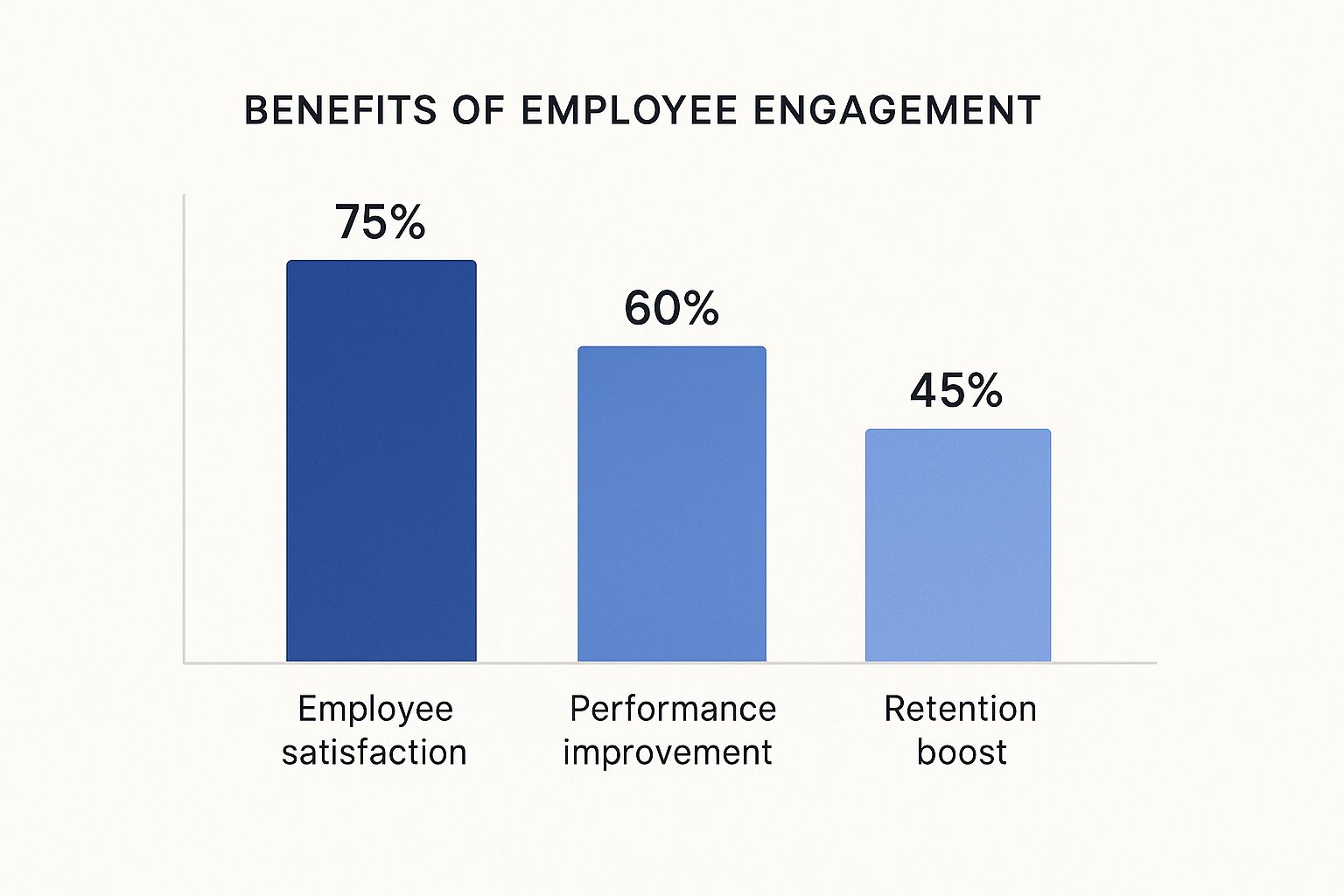Learning to give feedback that actually helps people grow is less about criticism and more about having consistent, developmental conversations. When you get it right, feedback stops being a source of anxiety and becomes a powerful tool for improvement. The trick is to be specific, timely, and focused on what comes next.
The Real Impact of Effective Feedback
Giving good feedback is one of the most powerful things you can do to unlock your team's potential and keep them motivated. It’s so much more than just a routine management task. Yet, there’s often a huge gap between the kind of feedback employees crave and what they actually get. The old model of the rigid, once-a-year performance review just doesn’t cut it anymore and leaves a void that directly hits engagement.
This isn't just a small hiccup in communication; it’s a major disconnect. Let's look at the numbers.
The Feedback Gap: What Managers Think vs. What Employees Experience
It’s easy for managers to feel like they’re communicating constantly, but the reality on the ground can be very different. This perception gap is one of the biggest hurdles to creating a strong feedback culture.
| Metric | Manager Perception | Employee Reality |
|---|---|---|
| Weekly Feedback Frequency | 50% of managers believe they give feedback weekly. | Only 20% of employees report receiving it that often. |
| Link to Engagement | N/A | Nearly half of highly engaged employees get weekly feedback. |
These numbers tell a clear story: consistent, frequent feedback is directly tied to how engaged your team feels. When managers think they're giving enough feedback but employees aren't feeling it, you have a critical blind spot that's likely holding your team back.
Feedback should be a conversation, not a verdict. When delivered with empathy and a genuine desire to help someone grow, it builds trust and reinforces that you're on the same team, working toward the same goals.
Why Prioritizing Feedback Matters
When you master this skill, you start building a culture where people feel seen, understood, and genuinely motivated to get better. Continuous, developmental feedback transforms from something people dread into an expected—and even welcomed—part of the daily workflow. This is absolutely essential if you want to hold onto top talent who are hungry for growth.
The benefits aren't just warm and fuzzy; they're clear and measurable. The data shows just how much well-delivered feedback can move the needle on key business outcomes.

As you can see, there's a direct line connecting effective feedback to higher employee satisfaction, real performance improvements, and a big jump in retention.
From Task to Culture
Ultimately, the goal is to stop treating feedback like an isolated event and weave it into the very fabric of your team’s operations. This means creating a space of psychological safety where people are comfortable giving and receiving input without fearing judgment. It's about building a system of continuous improvement where everyone is invested in the team's collective success.
The effectiveness of your feedback is also deeply connected to your team's overall communication climate. It's vital to improve overall workplace communication to make sure your message lands the way you intend it to. When trust and clarity form the foundation, feedback becomes the fuel for both innovation and personal growth.
How to Prepare for a Feedback Conversation
Meaningful feedback rarely happens by accident. If you’ve ever rushed into one of these conversations without a plan, you know how quickly it can go off the rails, leaving everyone feeling frustrated. To make sure your feedback actually helps, you have to do your homework first.
Start by defining a crystal-clear goal. Before you even think about sending a calendar invite, ask yourself: What is the one thing I need to achieve with this conversation? What specific behavior do you want the person to start, stop, or continue doing? Without that laser focus, the discussion will likely meander into vague, unhelpful territory.
Gather Your Facts, Not Feelings
To keep the conversation on track and productive, you need to bring specific, observable examples. Trust me, saying something like "you need more attention to detail" is the fastest way to get a defensive reaction. It's just not helpful.
Instead, you need to point to concrete moments that show what you mean. This means digging through recent projects, reports, or interactions. The goal here is to build your case on objective reality, not just your personal feelings or interpretations.
For instance, instead of saying "your reports are confusing," try this: "In last week's Q3 report, the revenue chart on page two didn't line up with the summary data on page four. That caused some confusion during the client presentation." See the difference? One is an accusation; the other is a factual observation.
To really nail this, you need to speak the language of results. Having a solid grasp of employee key performance indicators is crucial before you even start the conversation. It allows you to connect your feedback directly to the metrics that matter to the business.
Adopt a Coaching Mindset
Your mindset walking into the room is just as important as the words you choose. It sets the tone for the entire interaction. Are you showing up as a judge ready to deliver a verdict, or as a coach ready to help someone level up their game?
Your intent should be to facilitate learning, not just justify a grade or critique performance. When you frame feedback as a collaborative effort to solve a problem, you invite dialogue instead of defensiveness.
This shift is everything. It transforms the dynamic from a one-way lecture to a two-way discussion about growth. To get into this headspace, try these simple mental shifts before you meet:
- From Blame to Problem-Solving: Don't focus on who was wrong. Focus on what happened and how you can work together to make sure it doesn't happen again.
- From Past to Future: While you need past examples for context, the bulk of your conversation should be about "what's next."
- From Accuser to Ally: Remind yourself that you're on the same team. Their success is your success.
This kind of preparation helps you deliver feedback that feels supportive, not critical. For a deeper look at making your input stick, our complete guide on how to give constructive feedback has even more strategies to drive real results.
Structuring Feedback for Maximum Impact

How you say something matters just as much as what you say. Without a clear structure, even the best-intentioned feedback can feel like an ambush, immediately putting the other person on the defensive. The goal isn’t to follow some generic script, but to open up a genuine, two-way conversation.
When you get the framing right, a potentially tense moment transforms into a productive, forward-looking experience. It’s about building a bridge, not a wall. You're trying to invite collaboration, not just deliver a monologue. When feedback is structured with care, it stops being about what went wrong and starts being about how to succeed together.
The Power of Intent
Before you get into the nitty-gritty, always start by stating your positive intent. This one step can completely shift the dynamic of the conversation. It shows you’re there to support, not to criticize, which helps lower defenses from the get-go.
For example, you could open with:
- "I want to talk about the project deadline because I’m committed to your success and want to help you manage your workload effectively."
- "My goal here is to find a solution together so we can avoid this issue on future client reports."
- "I'm sharing this because I see a lot of potential in you and want to help you grow into a leadership role."
This simple framing makes it clear you're on their side.
The core purpose of feedback is to facilitate learning, not just to justify a grade or critique performance. Feedback that invites a response and encourages action is far more likely to be used for growth.
The impact of getting this right—or wrong—is huge. A recent report found that only about 21% of employees feel engaged at work, with the feedback gap being a major culprit. Thoughtful, well-structured conversations are a key part of the solution and can unlock massive productivity gains. To see the full picture, check out the key findings in Gallup’s 2025 State of the Global Workforce report.
From Observation to Action
Once you’ve set a collaborative tone, you can walk through the issue using a proven framework. One of the most effective models I’ve used connects a specific observation to its impact, and then opens the floor for a shared solution.
Here’s how it breaks down:
- State Your Specific Observation: Stick to the facts, no judgment. "I noticed in the client call yesterday that when the topic of budget came up, we moved on without confirming the next steps."
- Explain the Impact: Connect that observation to a real outcome. "The impact was that the client later emailed with several questions, which created some extra work and a bit of confusion for the team."
- Pause and Listen: This is the most important part. After you've laid out the situation, stop talking. Ask an open-ended question like, "What are your thoughts on that?" or "How did you see it?"
- Collaborate on a Solution: After you've heard their side, work together on what to do differently. "How can we make sure we lock down those details in the moment next time?"
This structure turns what could be a one-way critique into a powerful coaching opportunity, making the whole process feel supportive and effective.
Handling Difficult Reactions and Common Pitfalls

Even with the most careful preparation, you can't always predict how someone will react to feedback. Let's be real: human emotions are messy. Giving the feedback is only half the work. The real test of leadership is how you navigate the reaction that follows.
This is where you build genuine trust. The secret isn't to wield authority, but to stay calm and steer the conversation back with empathy.
When you’re met with a strong emotional response—tears, defensiveness, even anger—your first move is to just listen. Seriously. Don't interrupt or double down on your point. Take a breath and give them the space to process.
Acknowledge their feelings without necessarily agreeing with their interpretation of the situation. Simple phrases like, "I can see this is tough to hear," or "It sounds like you're really frustrated right now," can work wonders to de-escalate tension. It shows you’re a person, not just a manager delivering a verdict.
Navigating Common Feedback Traps
Beyond the heat of the moment, you need to be aware of the common traps that can completely derail your feedback. These pitfalls often feel like shortcuts, but they almost always backfire, eroding trust and rendering your feedback useless.
Here are a few of the most common traps to sidestep:
- The Vague Generalization: Avoid bombs like "You need to be more proactive" or "Your work is sloppy." Feedback like this is impossible to act on and just feels like a personal attack.
- The One-Way Lecture: Feedback has to be a dialogue. If you’re the only one talking, you're missing the other person's side of the story and a huge opportunity to solve the problem together.
- The Dreaded "Feedback Sandwich": We all know this one: praise, criticize, then praise again. It's a classic for a reason, but most people just brace for the "but" and see the positive bookends as insincere filler.
One of the biggest hurdles is the recipient's own mindset. If they've only ever experienced feedback as criticism, they'll have their guard up. Your job is to reframe it as a tool for growth by consistently avoiding these common mistakes.
Staying Focused on the Goal
When a conversation gets emotional or veers off track, it’s your job to gently guide it back to its purpose. After you’ve listened and validated their feelings, you can pivot back to the issue at hand.
Try saying something like, "I appreciate you sharing that with me. Can we circle back to the project report for a moment? I'd love to figure out a plan together for the next one."
This approach respects their perspective while refocusing the conversation on a collaborative, forward-looking solution. It reinforces that you're there to support them, not to punish them.
Giving Feedback in a Hybrid Workplace

Let’s be honest: giving feedback is tricky enough in person. When your team is spread out across home offices and the main headquarters, it introduces a whole new level of complexity.
Those casual desk-side check-ins and subtle body language cues we used to rely on? They’re gone. Now, it's far too easy for a well-intentioned message to get misread or just buried in a mountain of notifications. In a hybrid world, you have to be deliberate. A quick chat message might work for a minor typo, but real, constructive feedback almost always needs a video call. The channel you choose immediately signals the conversation's importance and shows respect for the person on the other end.
Creating Psychological Safety from a Distance
Building a safe space for feedback is just plain harder when you're not in the same room. Without the ability to read the room, team members might be silently struggling, and you might have no idea. This is why you have to be so intentional about forging connections and being crystal clear in your communication.
This isn't just a hunch; the data backs it up. With hybrid models now the norm for 53% of remote-capable employees, that old-school way of communicating just doesn't cut it. Teams that take the time to set up clear communication ground rules and prioritize real, meaningful interactions simply perform better.
Ultimately, having a solid feedback process is no longer a "nice-to-have." It's a critical piece of the puzzle for any team that wants to thrive in a hybrid setup.
Using the Right Tools for Contextual Feedback
When you’re working on digital projects, nothing kills productivity faster than vague feedback. We've all seen it—that dreaded Slack message that just says, "the design feels a bit off." That kind of comment can lead to hours of frustrating guesswork. This is where visual feedback tools really shine.
Tools like BugSmash let you give feedback right on the asset itself, whether it's a website, a PDF, or a video. Instead of trying to describe the problem, you can literally show it.
See how you can drop a pin on a specific part of a webpage and leave a comment? This instantly clears up any confusion. Everyone knows exactly what you're talking about, turning a potentially frustrating exchange into a clear, actionable task. For managers still getting the hang of this new way of working, this guide to conducting remote performance reviews has some great additional strategies.
In a remote setup, clarity is kindness. The more you can do to remove ambiguity and provide crystal-clear context, the more effective and supportive your feedback will be.
By bringing in tools that give you this kind of precision, you create a workflow that’s more efficient and a lot less frustrating for everyone.
Building a Continuous Feedback Culture
When your team isn't sharing an office, you can't rely on spontaneous chats to keep feedback flowing. You have to build that culture with intention.
Here are a few practical ways to keep the lines of communication open:
- Schedule Regular, Informal Check-Ins: Put recurring one-on-ones on the calendar that are just for open dialogue, completely separate from project meetings.
- Use Public Channels for Praise: When someone does great work, celebrate it in a shared team channel. Public recognition boosts morale and shows everyone what success looks like.
- Model Vulnerability: As a leader, be the first to ask for feedback on your own performance. This shows the team that feedback is a normal, healthy part of how you all work together.
These small, deliberate actions go a long way in creating a connected and supportive environment, no matter where your team members are logging in from. If you want to go deeper, check out our article on the best practices for feedback that transform workplace strategies.
Got Questions About Giving Feedback? We’ve Got Answers.
Even when you have a great framework in place, giving feedback can feel tricky. You're not alone. I’ve seen countless managers and team leads wrestle with the same practical questions. Getting comfortable with these common scenarios is what turns feedback from a stiff, formal process into a natural, effective part of your team's culture.
The real goal here is to stop treating feedback like a rare, scheduled event. It should be woven into the fabric of your team's weekly, or even daily, conversations. That’s how you build a real culture of continuous improvement.
How Often Should I Actually Give Feedback?
Think less about a rigid schedule and more about creating a continuous feedback loop. While you might have formal quarterly check-ins, informal, in-the-moment feedback should happen weekly, if not daily. Timeliness is everything; it keeps small issues from snowballing.
- For positive reinforcement: Give it immediately. When you see someone do great work, say something right then and there. It reinforces the exact behavior you want to see more of.
- For constructive feedback: Deliver it as soon as you can after the event, while the details are still fresh in everyone’s mind. Waiting weeks for a formal review makes the feedback feel disconnected and far less impactful.
This approach makes feedback a normal, supportive, ongoing conversation instead of a dreaded, high-stakes meeting.
What’s the Real Difference Between Constructive Feedback and Criticism?
It all boils down to intent. Criticism is all about pointing fingers and assigning blame for something that already happened. It often feels personal and judgmental, like a one-way street where you’re just told what you did wrong.
Constructive feedback is completely different—it’s forward-looking and designed to help someone grow. It zeroes in on specific behaviors and their impact, with the clear goal of helping that person succeed next time. It’s a collaboration, not a confrontation, aimed at finding a solution together. For a deeper look at this, our guide on how you can collect customer feedback with proven methods is a great resource, as many of the same principles of clarity and positive intent apply.
How Do I Give Feedback to My Manager or a Peer?
Giving feedback "upward" to a manager or sideways to a peer requires a bit more tact since you don't have the same positional authority. The way you frame it is critical. I’ve found the best way to start is by asking for permission, which shows respect for their time and signals that you’re offering help, not judgment.
A simple, non-confrontational opener works wonders. Try something like, "Hey, would you be open to hearing some of my thoughts on the project presentation?" This frames the conversation as a collaborative offer, not an unsolicited attack.
Once you have the green light, structure your feedback thoughtfully:
- Stick to "I" Statements: Always frame it from your own perspective. Instead of saying, "You confused everyone in that meeting," try, "I had a tough time following when the data was presented so quickly."
- Explain the Impact: Show them the result of the behavior. "Because of that, I had to circle back with a few people afterward to clarify some of the key points."
- Offer a Collaborative Suggestion: Turn it into a shared solution. "Maybe for the next one, we could pause for questions after each key slide? I think it would help everyone stay on the same page."
This approach keeps the conversation focused on the work and your shared goals, not on personality. It makes the feedback much easier to hear, accept, and act on.
Giving and receiving feedback shouldn't be a struggle. BugSmash eliminates confusing email threads and messy spreadsheets by allowing your team to leave clear, contextual comments directly on websites, images, PDFs, and videos. See how you can streamline your review process and make feedback painless at https://bugsmash.io/.




